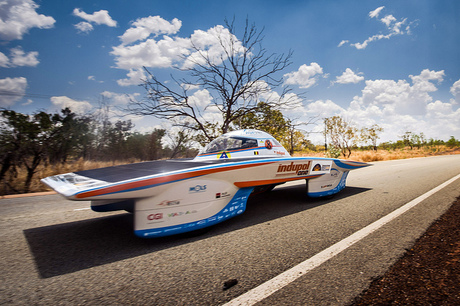Barrett supports solar car race team

On Sunday, 18 October, 46 teams from around the world set off on the Bridgestone World Solar Challenge — a 3000-kilometre journey from Darwin to Adelaide.
One of the many requirements is for all teams to maintain reliable communications within each team and with emergency services, should that be required.
The Belgium Punch Powertrain Solar Team has enlisted the assistance of Barrett Communications to supply and manage its short- and long-range HF communications.
The Punch Powertrain Solar Team convoy will comprise eight vehicles including the solar car.
“In past challenges we have used satellite phones, which have been very expensive for the extensive communications required over the 8-day race, and we found them to be sometimes unreliable due to atmospheric conditions,” said Karel Winderickx, the team’s public relations and events specialist.
“Following the 2013 event, we identified communications as an area we wanted to reassess,” he added. “It was recommended that we talk with Barrett Communications directly to see if they would be interested in being involved in the 2015 challenge.
“We were excited when Barrett was keen to be involved and provide a vehicle and staff to manage our communications.”
Each of the vehicles will have UHF communications, as six of the vehicles will be no more than a couple of kilometres away from each other. However, the lead vehicle, known as ‘Eagle’, will be 100 km in front of the solar car — its responsibility is to be the weather vehicle and advise of conditions ahead.
All of this information will be communicated to ‘Brains’, the vehicle directly trailing the solar car, over HF.
Eagle will have a full voice, email and data system, including the Barrett 2050 HF SSB transceiver, the Barrett 2020 Email, fax and data system, the Barrett 2019 Automatic tuning antenna and the Barrett 2018 Mobile magnetic loop antenna.
The Barrett 2018 uses NVIS (near-vertical incidence skywave) to overcome dead zones, a common limitation of typical mobile whip antennas, and is highly effective over the short distance between vehicles.
The Barrett 2019is a whip-based antenna, ideal for long-distance communications to the base station in Alice Springs.

“This system is ideally suited to this scenario,” said Greg O’Neill, managing director at Barrett Communications.
“This system will allow Eagle to communicate with Brains over voice and for Eagle to communicate with the base station in Alice Springs… over voice, email and data, which will then connect into the phone network via the internet back to the Barrett Communications head office in Perth.
“They will be utilising the GPS vehicle tracking software as part of the Barrett 2020 Email, fax and data system, which will give real-time location details on Google Maps, which we will be streaming live to our website,” O’Neill added.
Customised rugged tech shaping the next era of defence comms
Rugged computing platforms are becoming central to how armed forces protect communication...
A guide to aquatic survival this summer
While most Australians are planning aquatic adventures this summer, less than a third are...
Maher Terminals enhancing operations with private wireless
Maher Terminals chose the Nokia Edge platform because it needed a secure, reliable,...



